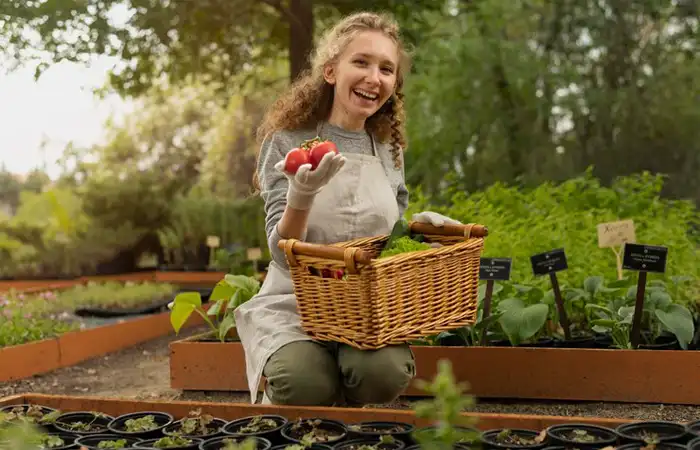
Blog
Harvest Joy Culinary Adventures with Homegrown Vegetables

Growing veggies in your own garden at home has a lot of benefits. It gives you a sustainable supply of fresh vegetables, but it also lets you get closer to the natural world, lessen your impact on the environment, and have the satisfaction of gathering your own food. You can have a successful vegetable garden at home, no matter how big or little your backyard or balcony. This is how to begin your quest to gather happiness..
Evaluate Your Area and Natural Light.
Assess the Space You Have Available
Examine your outside area, be it a patio, balcony, lawn, or simply a sunny windowsill. Determine how much space you have for gardening and select the right planters or garden beds for the space you have available.
Think About Sunlight Needs
For optimal growth, most veggies need six to eight hours of sunshine each day. Choose veggies that are appropriate for the quantity of sunshine available by keeping an eye on the patterns of sunlight in the gardening area you have chosen.
Select Your Vegetables.
Choose Vegetables Based on Climate
Select veggies that will thrive in the growing conditions and climate of your area. When choosing veggies for your garden, keep things like temperature, humidity, and the dates of the first frost in mind.
Choose easy to grow varieties first.
Start with simple to grow produce like tomatoes, lettuce, peppers, and herbs if new to gardening. Novice gardeners may effectively cultivate these veggies since they require little upkeep.
Get Your Soil Ready.
Boost the Quality of the Soil
To increase soil structure and fertility, prepare your soil by adding organic matter like as compost, aged manure, or leaf mold. Using a tiller or garden fork, incorporate the organic materials into the top few inches of soil.
Check the pH of the soil.
To make sure the pH of your soil is within the ideal range for vegetable development, think about testing it. Most veggies want their soil to be between 6.0 and 7.0 pH, which is somewhat acidic.
Sow Your Vegetables.
Observe planting guidelines.
Observe planting recommendations, taking into account depth, spacing, and timing for every variety of vegetable. Refer to the seed packs or gardening guides for detailed planting instructions for every type of vegetable.
Think About Planting Companions
To make the most of available space and deter pests, grow complementary veggies together in a companion planting strategy. For instance, grow radishes next to cucumbers to ward off cucumber bugs, or basil next to tomatoes to enhance flavor and ward against pests.
Give Sufficient Care.
Drink Water Often
Give your vegetable garden frequent watering, particularly in arid or warm weather. Maintain a constant moisture content in the soil, but avoid overwatering as this can cause root rot and other issues.
Mulch and Weed
To retain moisture, inhibit weed growth, and control soil temperature, mulch the area surrounding your vegetable plants. Weed your garden often to avoid competing for water and nutrients.
Observe for diseases and pests.
Check Plants Frequently
Regularly check your vegetable plants for symptoms of pests or illnesses, such as wilting, discolouration, or holes in the leaves. To stop issues from spreading to other plants, recognize them early on and take appropriate action.
Apply Integrated Pest Control.
In your vegetable garden, use integrated pest management IPMÂ approaches to control diseases and pests. To manage pests while causing the least amount of harm to beneficial creatures and the environment, this may involve employing physical barriers, organic insecticides, or helpful insects.
Gather and Savor.
Harvest Appropriately
When the veggies are at their ripest, they have the most nutritional content and taste. Harvest veggies with clean, sharp garden shears or scissors, being careful not to bruise or harm the plants.
Savor the Results of Your Hard Work
Savor the flavor of your own freshly produced veggies as you celebrate the bounty. There is nothing quite like the taste of fresh vegetables, whether you use it in salads, curry, soups, or just eat it raw.
In summary.
Vegetable gardening at home is a gratifying and enjoyable hobby that lets you enjoy the freshest, most flavorful produce available, lessen your environmental impact, and establish a connection with nature. You may grow a healthy vegetable garden at home by evaluating your available area and sunshine, selecting the appropriate veggies, prepping your soil, planting properly, giving your plants enough care, keeping an eye out for pests and illnesses, and harvesting when the time is perfect. Now roll up your sleeves, get your hands dirty, and prepare to harvest happiness from your own crops that you have cultivated.
4 Comments
Leave a Reply














Noah
Thanks for the fantastic ideas!
James
Thanks for the great tips overall.
Charles
Keep up the great work!.
Marie Johnson
Thank you for the detailed tutorial and creative ideas!